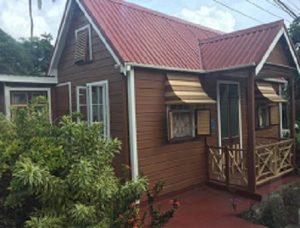
Submitted By Jacqueline Warner on the 2017 winter session program in Barbados sponsored by the Department of Human Development and Family Studies…
Today was all about learning about the culture in Barbados, which is more complex than I had ever imagined. We had a meeting with Ian Walcott Skinner who is a cultural advocate who works on the island. He gave us a brief synopsis of the history and the culture of the island. I’m going to literally copy and paste the following from my notes so I have everything important that we learned: Skinner’s definition of culture, “culture is the implicit and explicit behavior of the people that happens in a particular space or spaces over a period of time”. To understand culture you have to look at the background and history of a place. Before 1500 there were natives who came from what is now South America called the arrilacks and the caribs. We get the name Caribbean as a combination of arrilack and carib. Barbados was named after the Portuguese who discovered it and called it Os Barbados, meaning bearded man, because of the bearded fig trees all over the island. The Portuguese were the first Europeans to arrive on the island and eventually the British came to colonize the island and use it as a place to grow valuable sugarcane. On August 1st 1838, the slaves were emancipated and this date is now celebrated as “crop over festival”. After the emancipation, however, former slaves and their descendants were forced to live on the rocky coast and work on former plantations for little money as part of a system similar to share-cropping in the United Sates. This did not end until after Barbados gained its freedom in 1966. The crop over festival that I mentioned earlier was created as a celebration of the slaves after all of the crops were harvested and their hard work was done, the masters allowed them a few days to drink and celebrate. This celebration continues today and includes their independence day as it occurs at the end of July and beginning of August. Bajans struggled to find their own kind of culture and celebrations after their freedom from the UK because most of their culture was either British or African. Today, crop over remains as one of the first cultural events that they had after their freedom and Bajans continue to form their own culture.
One important part of the culture today is the landscape of the island and how homes are built. The grand plantations and large churches, as well as many modern and newer buildings like hotels, were made of limestone and coral bricks that were available on the island. The smaller homes that most slaves lived in were called Chattel homes. Slaves made these out of wood and they are able to be distinguished today by their windows that fold up and down. These homes were built specifically to withstand hurricanes, but also to be taken apart and carried from plantation to plantation. If the work was not good at one plantation, a slave might pick up their house and move somewhere better. These homes can still be found on the island, and many people still live in them although they have been cemented to the ground and they have been improved upon. One cool thing about these houses is that they do not need AC because of the design of the windows, air moves in and out easily.

Much of the food on the island is also related to culture. Fish is a large market on the island, especially for tourists, and many people eat that and chicken, lamb or goat. These are all things that can be grown on the island, as well as many fruits found on the island. This comes from slave times because slaves often ate what they could and what they found around the island. Slaves also were given the worst parts of the animals, especially pigs, such as tongues, stomachs and ears. In Barbadian culture today, these parts of the animal are considered delicacies. One other very popular dish that I am very fond of myself, is macaroni pie. This comes from housekeepers making easy dishes for their masters or owners and then adding more cheese and spices to eat it themselves. Everywhere on the island, the macaroni pie is a little bit different according to family recipe, the way the chef likes to eat it or just how they like to make it.
After class, I hung by the pool before we went to the local fish fry on the south coast called Oistens. We took two taxis down and were led into a busy market of shops all selling dinners out of chattel homes. After a long wait, we were seated, and then there was a forty minute wait for food, and a thirty minute wait for the check. I had swordfish, sweet potatoes, and macaroni pie as well as three salads (macaroni, coleslaw, and garden) that all plates come with. Our waitress was very sweet and we gave her a big American tip (that’s what we Americans are known for after all) and then we went to dance. There was a live DJ on a stage where many people were dancing. There were men who would go on stage and dance and a few tourists who joined them. We all watched the crowd as it got larger and larger before we left at ten til eleven.
